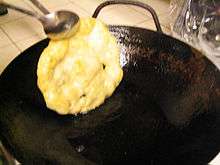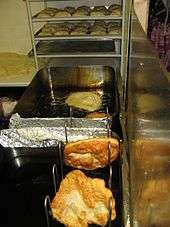Lángos
|
Lángos topped with grated cheese, sour cream, bacon, onion and parsley | |
| Alternative names | Lalanga |
|---|---|
| Type | Flatbread |
| Place of origin | Hungary |
| Main ingredients | Flour, yeast, salt |
|
| |
Lángos (Hungarian pronunciation: [ˈlaːŋɡoʃ]; Turkish: lalanga[1]) is a Hungarian food speciality, a deep fried flatbread.[2][3] It is also traditionally made in Vojvodina, Serbia, where it was introduced by the local Hungarians.
Variations
The dough for lángos is made of water or milk and flour, yeast, sugar and salt.[2][3] Adding sour cream, yoghurt or mashed potatoes to the dough is optional, in the latter case it is called potato lángos (in Hungarian krumplis lángos).[3] It is eaten fresh and warm, topped with sour cream and grated cheese, or Liptauer, ham, or sausages, or most frequently, without toppings, just rubbed with garlic or garlic butter, or doused with garlic water. Other ingredients and accompaniments can be mushroom, quark cheese, eggplant, cabbage, kefir, omelet, and a confectioner's sugar or jam.

Traditionally lángos was baked in the front of the brick oven close to the flames. This is the basis for its name; "láng" means "flame" in the Hungarian language. Lángos was made from bread dough and was served as breakfast on the days when new bread was baked. Now that people no longer have brick ovens and do not bake bread at home, lángos is virtually always fried in oil.
Lángos is popular all year long. As it is a rather affordable and simple food, it is often sold around bus stations, fairs, and all over Eastern European countries on local celebrations or sport events. It is sold at many fast-food restaurants not only in Hungary but also in Austria.[4] In Austria, especially in Vienna, lángos is very popular as a fast food at fairs and in amusement parks like the Prater. Lángos is known in the Czech Republic, Slovakia and Croatia as langoš, in Serbia as languš (although it is commonly called "Mekike"). It is also popular in Romania as langoși.It is also extremely popular in Poland where it is known as "langosz" and in the UK where it's called "langos" or "Hungarian Fried Bread." Lángos is popular in all of the countries which were carved out of Hungary after World War I and where ethnic Hungarians lived for over 1000 years.
Etymology and history

The name comes from láng, the Hungarian word for flame.
The early-15th-century Glossary of Beszterce,[5] the most ancient currently known Hungarian "dictionary", reveals that the ultimate ancestor of flat breads was the panis focacius attributed to the Romans (of which derives also the Italian flat bread called focaccia). In ancient Rome, panis focacius[6] was a flat bread baked in the ashes of the fireplace (cf. Latin focus meaning "fireplace"). However, the modern lángos, despite its name, is not prepared near an open flame but rather by deep-fat frying, and among Hungarian foods it is instead the pogácsa which preserves the connection, both etymological and culinary, to the ancient panis focacius.
Lalanga was present both in the Byzantian and Ottoman cuisines; while in the first one it was only eaten as a sweet, in Ottoman Turkey it was eaten both as a sweet (with honey) or as a savoury dish with cheese.[7] Lalanga continues to exist in the Turkish cuisine,[8] as well as in the Greek Cuisine (mostly in Peloponnese) as Lalagia (In Greek Λαλάγγια).[9]
Similar dishes
Lángos is very similar to a version of frybread made by the Indigenous peoples of the Americas. Lángos is also similar to Bulgarian mekitsa, Central Asian shelpek, Indian bhatoora, and Canadian BeaverTails.
See also
- List of doughnut varieties
- Chiburekki
- Focaccia
- List of deep fried foods
- List of quick breads
- National symbols of Hungary
-
 Food portal
Food portal
References
- ↑ http://www.rotahaber.com/yemek/detay.asp?hid=294001
- 1 2 Hungarian lángos
- 1 2 3 June Meyers Authentic Hungarian Heirloom Recipes Cookbook
- ↑ German Langoschrezepte
- ↑ Glossary
- ↑ Panis focacius
- ↑ Marianna Yerasimos (2002). 500 yıllık Osmanlı yemek kültürü: günümüze uyarlanmış 99 Osmanlı yemeği : Osmanlı mutfağı. Boyut Yayınları.
- ↑ Türkiye Ekonomik ve Toplumsal Tarih Vakfı (1994). Dünden bugüne İstanbul ansiklopedisi. Kültür Bakanlığı. ISBN 978-975-7306-06-1.
- ↑ "Fried dough (Lalagia) | gourmed.com". gourmed.com. Retrieved 2016-08-10.
External links
 Media related to Langos at Wikimedia Commons
Media related to Langos at Wikimedia Commons


